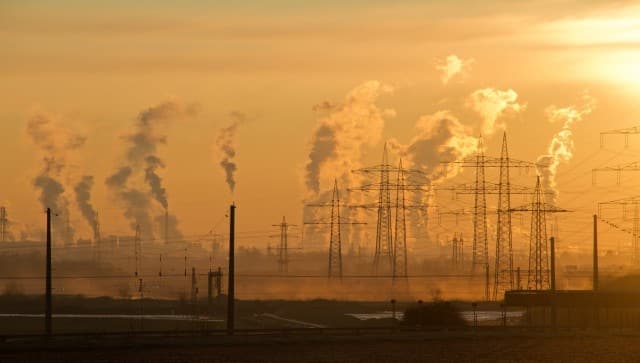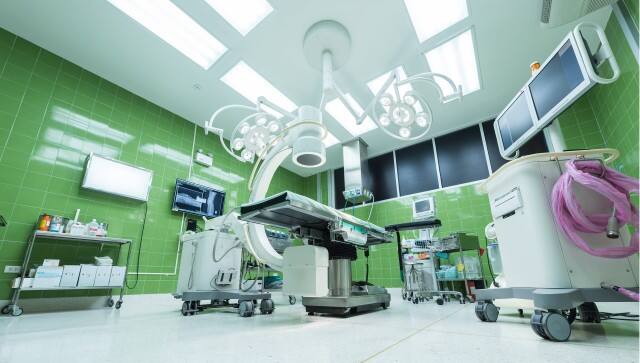For the foreseeable future, climate change will continue to have an impact on our daily lives, as it does now. According to a latest report, if fossil fuels are not phased out quickly, thousands of hospitals worldwide could close entirely or partially due to extreme weather. The report comes just before health day at the ongoing COP28 UN climate summit in Dubai. Approximately two lakh hospitals worldwide, including 53,473 in India, were examined between 1990 and the end of the century to determine their potential for harm from six climate change threats, including coastal inundation and local floods. Global hospitals at risk of closure Without a change in pace, a total of 16,245 hospitals — double the number of those that are currently at high risk — will fall into this category by the end of the century, according to a report released on Saturday by climate risk analyst Cross Dependency Initiative (XDI). It further states that a building, whether residential or commercial, with this degree of danger would not be considered uninsurable. According to the report, since 1990, greenhouse gas emissions have already raised the chance of extreme weather-related hospital damage by 41 per cent. [caption id=“attachment_13463382” align=“alignnone” width=“640”] Long-term shifts to temperature and weather patterns are referred to as climate change. Pexels/Representative[/caption] “Climate change is increasingly impacting the health of people around the world. What happens when severe weather results in hospital shutdowns as well? Our analysis show that without a rapid phase-out of fossil fuels, the risks to global health will be exacerbated further, as thousands of hospitals become unable to deliver services during crisis,” The Guardian quoted Dr Karl Mallon, director of science and technology at XDI, as saying. Many of the hospitals will need to be relocated at significant financial expense, even though some can be made resilient to the effects of extreme weather occurrences like hurricanes, strong storms, flooding, and forest fires. This will primarily affect lower- and middle-income countries, where 71% (11,512) of the hospitals at danger by the century are located. This is similar to many other effects of climate break down. South-east Asian hospitals at the highest risk The report suggests the greatest proportion of hospitals in South-east Asia are now at high risk of damage from extreme weather events. 3,357 hospitals, or one-third of the world’s high-risk hospitals are at the risk. The estimate indicated that by 2100, this figure might rise to 5,894. It will also face risks in the future; due to high emissions, nearly one in five hospitals (18.4 per cent) in the region may close entirely or in part by the end of the century. According to The Guardian, Prof Nick Watts, director of the Centre for Sustainable Medicine at the National University of Singapore, said, “It is clear that climate change threatens to undermine the stability of the health systems our patients and communities depend on. Whether it results in the closing of health facilities, or a clinic becoming overwhelmed with rising burdens of disease, the human consequences are dire.” The impact is “nothing less than catastrophic”, Eloise Todd, executive director, Pandemic Action Network, said, as per Hindustan Times, adding, “The chain reaction that climate change puts into action must be stopped at the source by ending the burning of fossil fuels.” [caption id=“attachment_13463412” align=“alignnone” width=“640”]
Long-term shifts to temperature and weather patterns are referred to as climate change. Pexels/Representative[/caption] “Climate change is increasingly impacting the health of people around the world. What happens when severe weather results in hospital shutdowns as well? Our analysis show that without a rapid phase-out of fossil fuels, the risks to global health will be exacerbated further, as thousands of hospitals become unable to deliver services during crisis,” The Guardian quoted Dr Karl Mallon, director of science and technology at XDI, as saying. Many of the hospitals will need to be relocated at significant financial expense, even though some can be made resilient to the effects of extreme weather occurrences like hurricanes, strong storms, flooding, and forest fires. This will primarily affect lower- and middle-income countries, where 71% (11,512) of the hospitals at danger by the century are located. This is similar to many other effects of climate break down. South-east Asian hospitals at the highest risk The report suggests the greatest proportion of hospitals in South-east Asia are now at high risk of damage from extreme weather events. 3,357 hospitals, or one-third of the world’s high-risk hospitals are at the risk. The estimate indicated that by 2100, this figure might rise to 5,894. It will also face risks in the future; due to high emissions, nearly one in five hospitals (18.4 per cent) in the region may close entirely or in part by the end of the century. According to The Guardian, Prof Nick Watts, director of the Centre for Sustainable Medicine at the National University of Singapore, said, “It is clear that climate change threatens to undermine the stability of the health systems our patients and communities depend on. Whether it results in the closing of health facilities, or a clinic becoming overwhelmed with rising burdens of disease, the human consequences are dire.” The impact is “nothing less than catastrophic”, Eloise Todd, executive director, Pandemic Action Network, said, as per Hindustan Times, adding, “The chain reaction that climate change puts into action must be stopped at the source by ending the burning of fossil fuels.” [caption id=“attachment_13463412” align=“alignnone” width=“640”] Governments are being urged by XDI to inspect hospitals in their area in order to safeguard the hospitals that are listed, along with their locations and names. Pexels/Representative[/caption] 10 per cent of hospitals in India may have to relocate or close due to climate change by the end of the century. According to the XDI Global Hospital Infrastructure Physical Climate Risk Report, Nepal, where 26 per cent of hospitals could close, and India, which is currently the third-largest emitter of greenhouse gases, would be among the hardest hit. 5,120 hospitals in India, or 9.6 per cent of all hospitals, would be at high risk of closing by 2100, the 50-nation analysis stated. China, too, will be impacted with over 15 per cent of the hospitals at risk. The responsibility Governments are being urged by XDI to inspect hospitals in their area in order to safeguard the hospitals that are listed, along with their locations and names. “Governments have a duty to population to ensure the ongoing delivery of critical services. For individual governments not to take action on this information, or for the global community not to support governments in need, is blatant disregard for the wellbeing of their citizens,” Mallon said. According to Dr Vivek Desai of Hosmac, a hospital management consulting company, there isn’t much “environmental consciousness” in hospitals. He believes there would be just about a dozen genuinely green hospitals in the entire nation. “The government of India has made it mandatory for public hospitals to have a GRIHA 3 rating but this is not mandatory for private hospitals,” The Times of India quoted him as saying. The Green Rating for Integrated Habitat Assessment, or GRIHA, establishes guidelines for what qualifies as a “green building.” The majority of private hospitals are reluctant to implement green features due to the initial expenses. “If the government provides incentives such as a reduction in electricity or property tax bills, then hospitals may want to adopt green technologies,” Dr Desai suggested. Climate change Long-term shifts to temperature and weather patterns are referred to as climate change. For the last 200 years, human activity has been the primary driver of climate change. Burning fossil fuels, such as coal, oil, and gas, is one of the main culprits; the greenhouse gases released as a result serve as a blanket over the Earth, trapping solar heat and boosting temperatures. According to BBC, researchers have estimated that since the industrial revolution, the Earth’s surface has warmed by roughly 1.1 degrees Celsius. The latest analysis says the danger to hospital infrastructure would be halved if warming were limited to 1.8 degrees Celsius and fossil fuels were phased out quickly. This is in comparison to a high emissions scenario. The United Nations said in its Emissions Gap 2023 Report on 20 November that the globe is currently on track to warm by 2.5 to 2.9 degrees Celsius over the pre-industrial era. “The most obvious thing to dramatically reduce this risk to hospitals, and keep communities safe, is to reduce emissions,” Mallon said.
Governments are being urged by XDI to inspect hospitals in their area in order to safeguard the hospitals that are listed, along with their locations and names. Pexels/Representative[/caption] 10 per cent of hospitals in India may have to relocate or close due to climate change by the end of the century. According to the XDI Global Hospital Infrastructure Physical Climate Risk Report, Nepal, where 26 per cent of hospitals could close, and India, which is currently the third-largest emitter of greenhouse gases, would be among the hardest hit. 5,120 hospitals in India, or 9.6 per cent of all hospitals, would be at high risk of closing by 2100, the 50-nation analysis stated. China, too, will be impacted with over 15 per cent of the hospitals at risk. The responsibility Governments are being urged by XDI to inspect hospitals in their area in order to safeguard the hospitals that are listed, along with their locations and names. “Governments have a duty to population to ensure the ongoing delivery of critical services. For individual governments not to take action on this information, or for the global community not to support governments in need, is blatant disregard for the wellbeing of their citizens,” Mallon said. According to Dr Vivek Desai of Hosmac, a hospital management consulting company, there isn’t much “environmental consciousness” in hospitals. He believes there would be just about a dozen genuinely green hospitals in the entire nation. “The government of India has made it mandatory for public hospitals to have a GRIHA 3 rating but this is not mandatory for private hospitals,” The Times of India quoted him as saying. The Green Rating for Integrated Habitat Assessment, or GRIHA, establishes guidelines for what qualifies as a “green building.” The majority of private hospitals are reluctant to implement green features due to the initial expenses. “If the government provides incentives such as a reduction in electricity or property tax bills, then hospitals may want to adopt green technologies,” Dr Desai suggested. Climate change Long-term shifts to temperature and weather patterns are referred to as climate change. For the last 200 years, human activity has been the primary driver of climate change. Burning fossil fuels, such as coal, oil, and gas, is one of the main culprits; the greenhouse gases released as a result serve as a blanket over the Earth, trapping solar heat and boosting temperatures. According to BBC, researchers have estimated that since the industrial revolution, the Earth’s surface has warmed by roughly 1.1 degrees Celsius. The latest analysis says the danger to hospital infrastructure would be halved if warming were limited to 1.8 degrees Celsius and fossil fuels were phased out quickly. This is in comparison to a high emissions scenario. The United Nations said in its Emissions Gap 2023 Report on 20 November that the globe is currently on track to warm by 2.5 to 2.9 degrees Celsius over the pre-industrial era. “The most obvious thing to dramatically reduce this risk to hospitals, and keep communities safe, is to reduce emissions,” Mallon said.
Explained: How extreme weather could cause closure of thousands of hospitals globally
FP Explainers
• December 4, 2023, 14:02:59 IST
According to a latest report, if fossil fuels are not phased out quickly, thousands of hospitals worldwide could close entirely or partially due to extreme weather. In India, 10 per cent of hospitals may have to relocate or close due to climate change by the end of the century
Advertisement
)
End of Article